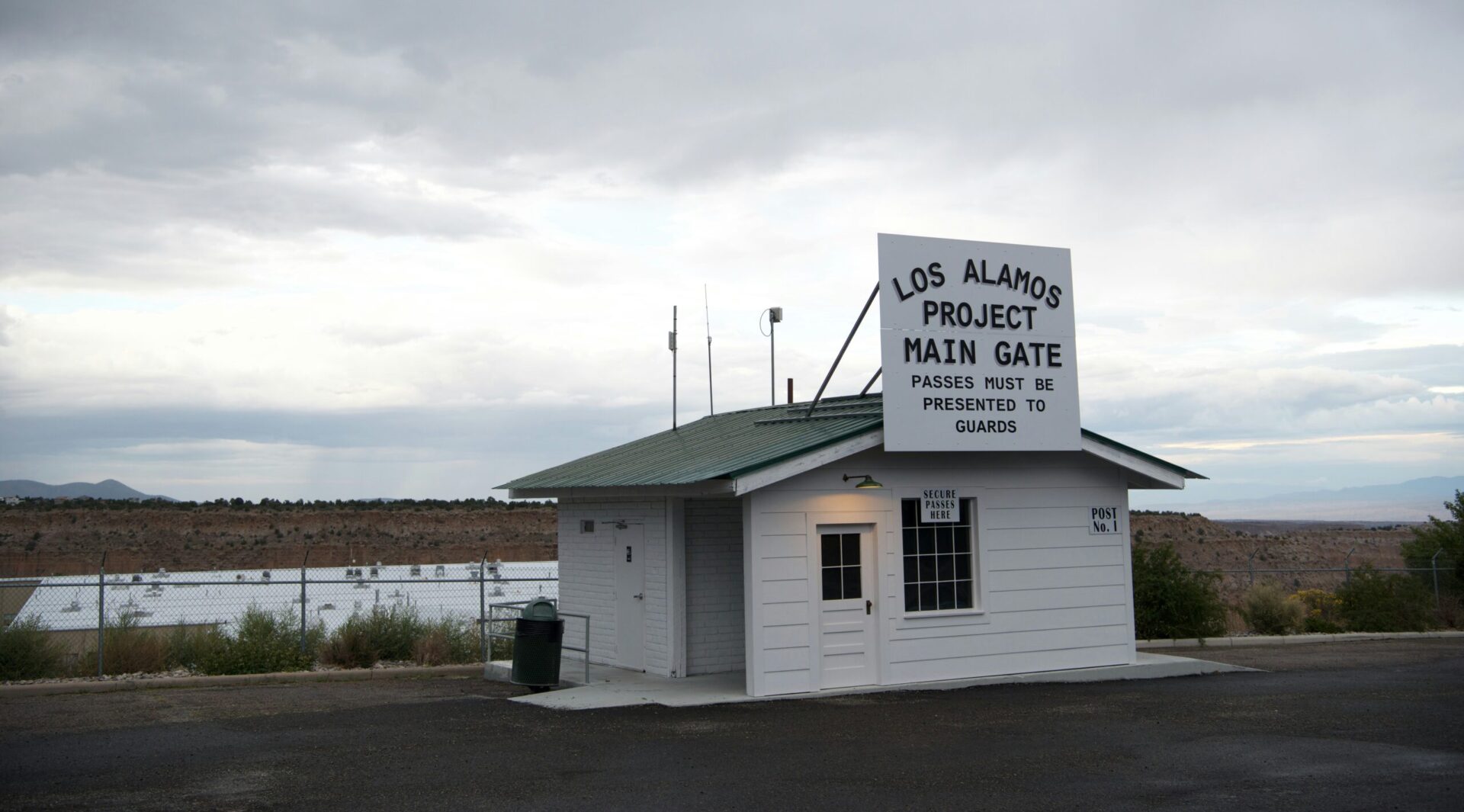Sprinkled across five western states, in silos buried deep underground and protected by reinforced concrete, sit 400 intercontinental ballistic missiles. Each of those missiles is equipped with a single nuclear warhead. And each of those warheads is itself equipped with one hollow, grapefruit-sized plutonium pit, designed to trigger a string of deadly reactions.
All of those missiles are on “hair-trigger alert,” poised for hundreds of targets in Russia — any one of which could raze all of downtown Moscow and cause hundreds of thousands of casualties.
Except — what if it doesn’t? What if, in a nuclear exchange, the pit fizzles because it’s just too old? In that case, would the weapon be a total dud or simply yield but a fraction of its latent power?
Outwardly, at least, that’s the question driving a whole new era of plutonium pit production at Los Alamos National Laboratory (LANL) and the Savannah River Plutonium Processing Facility in South Carolina.
Plutonium is widely known as one the most exotic elements in the periodic table. Trace amounts of it have been identified in the earth’s crust, though all of what’s now used for America’s nuclear weapons is manmade. For decades, these pits were cast with plutonium and other materials at a breakneck pace, installed in warheads and strapped into missiles that were regularly upgraded and modernized in an escalating arms race with the Soviet Union. Plutonium pits were never intended to grow old and senescent.
“We never worried about aging,” said Siegfried Hecker, former director of LANL and one of the world’s leading plutonium experts. “Because bombs were supposed to be out there for a dozen years or so.”
It’s been almost 40 years since America’s Cold War pit factory at Rocky Flats near Denver was raided by FBI agents and closed due to environmental crimes — among them, releases of radioactive effluent into nearby waterways. In that time, pit production went largely dormant, the USSR collapsed, arms reductions treaties were signed, stockpiles reduced and underground testing ceased.
Now, as the nuclear industrial complex awakens from its long slumber, the resumption of plutonium pit production has emerged as a deeply polarizing and political act. Anti-nuclear activists have accused the federal government of exploiting the uncertainty around aging to jumpstart a nearly $60 billion dollar manufacturing program. They assert that the real reason America has resumed the production of pits is for the purpose of introducing a new generation of warheads for a new generation of missiles — the first of which is the Sentinel, one of the most complex and expensive programs in the history of the US Air Force.
The Sentinel ICBM has the capability to carry three separate warheads, each with its own target. Earlier versions of America’s missiles could and did have such capabilities and the option has remained available, but with post-Cold War weapons reductions, the number of warheads per missile was also reduced — one warhead, one intercontinental ballistic missile. As the US, Russia and China barrel toward a new Cold War, the US will likely eschew such a convention in a matter of years.
“The issue of plutonium pit aging is a Trojan horse for the nuclear weaponeers enriching themselves through a dangerous new arms race,” said Jay Coghlan, executive director of Nuclear Watch New Mexico, an anti-nuclear group based in Santa Fe. “Future pit production is not about maintaining the existing, extensively tested stockpile. Instead, it’s for deploying multiple new warheads on new intercontinental ballistic missiles.”
“Unusual”
But to hear Hecker and his colleagues tell it, the question of pit aging is as scientifically vexing as it is political. Plutonium, to its most studied acolytes, borders almost on the mystical, its properties as capricious as the human body. It can be brittle or soft under some circumstances or turn to powder when heated in air. It can disintegrate at room temperature. It can bombard itself with radiation and mar its own internal lattice structure. It can even heal that damage within fractions of a second, if not over the course of several decades.
According to Glenn Seaborg, former chair of the Atomic Energy Commission and the chemist credited with first synthesizing the element for use in weapons, plutonium is “so unusual as to approach the unbelievable.”
This quality means that even the most knowledgeable experts are reluctant to commit themselves to anything definitive when it comes to a plutonium pit’s long-term prospects. Does it last 50 years? One hundred? Is it comparable to a human body, whose bones weaken and whose mind is vulnerable to dementia? Or is it actually impervious to entropy?
“It is difficult to quantify how much the properties of a plutonium pit will change over time,” wrote Marvin Adams, the deputy administrator for defense programs at the National Nuclear Security Administration (NNSA) in an email to Searchlight. It’s “even more difficult,” he went on, “to quantify how much those changes will affect weapon performance under all relevant conditions.”
The global nuclear landscape is not only more dangerous but also more dynamic than it has been in some time.
– Jill Hruby
In an election year obsessed with issues around aging, it is almost impossible to shrug off such questions. One need only look at America’s Presidential race, “a contest of the ancients,” as it was recently described. Biden is 81. Trump is 77. And America is watching both decline in real time.
Coincidentally, America’s plutonium pits are also estimated to hold their power for a good 85 years, and some estimates give them decades more. Much of the current stockpile is about 40 years old, which suggests there is no looming crisis.
The mystery of pit aging has nonetheless been at the heart of numerous studies conducted over decades at LANL and Lawrence Livermore National Laboratory (LLNL). In 2006, each lab released its findings to JASON, an independent and elite group of scientists that’s been advising the federal government since the Cold War, for review. JASON’s conclusion: “Most plutonium pit types have credible lifetimes of at least 100 years.” Half a dozen years later, researchers at LLNL were able to artificially age plutonium to 150 years. Those plutonium samples, researchers stated at the time “continue to age gracefully.”
But, come 2019, the political tide had changed. With President Donald Trump in office and a receptive Congress backing a plan to reinstate pit production, JASON was not convinced that enough studies on aging had been conducted in recent years. The group urged more studies. It also urged that “pit manufacturing be re-established as expeditiously as possible,” the brief report read.
Many saw it as a hedge against the future, for in the time it took pit production to lumber to life, JASON warned that America’s oldest pits might actually turn 80. At the same time, federal agencies continued to vaunt pit aging as a primary reason for building production lines in New Mexico and South Carolina — even as designs for another generation of weapons were in the offing.
“The global nuclear landscape is not only more dangerous but also more dynamic than it has been in some time,” said NNSA Administrator Jill Hruby at the Nuclear Deterrence Summit last month. As a result, she added, “we must be ready to deter two near-peer nuclear powers within a decade.”
And indeed, tensions have peaked. As Russia invaded Ukraine in 2022, it simultaneously launched a series of clandestine military satellites into space, recent reports claim. American spy agencies fear that Vladimir Putin will put a nuclear weapon in orbit, holding hostage much of the world’s telecommunications satellites should adversaries refuse his demands.
China, for its part, has produced nuclear weapons at a frightening pace since 2020 and the Pentagon forecasts the country will only continue on that trend, tripling its arsenal from its current estimated 500 weapons to 1,500 by 2035.
To make pits now, the argument goes, is to ensure against the unknowns to come, to deter adversaries and to show, after such a long hiatus, that the US retains the capability to build pits at an industrial scale. It’s the same argument that has been made for decades — often most loudly right here in New Mexico and most recently by Democratic Senators Ben Ray Luján and Martin Heinrich.
“‘It’s sort of glass half full, glass half empty; we can’t prove that they will fail, but we also can’t prove that they will work,’” said LANL director Thom Mason in a 2021 lab publication. “The best way to deal with this dilemma,” is to “‘take it off the table. … We do that by making new pits, immediately.’”
“Too Big to Fail”
The political machinations actually go back even further — to the 2010 concession that President Barack Obama made to a largely Republican bloc of Senators: arms control in exchange for a revival of the nuclear weapons complex.
“The deal was that in return for Senate ratification of the New [Strategic Arms Reduction Treaty], Obama would support a modernization plan that would modernize literally almost every aspect of the entire US nuclear arsenal,” explained Sharon Weiner, an associate professor at the School of International Service at American University.
At the time, the deal was heralded as a rare moment of bipartisan consensus. Today, experts look back on it as the beginning of a new era, a tectonic modernization of America’s nuclear triad — land, sea and air — now projected to cost close to $2 trillion over the next 30 years. That’s roughly the GDP of Canada.
Plutonium pits, of course, represent only a small fraction of the cost. That mind-boggling figure reflects a total reimagining of the nation’s entire nuclear program, complete with brand new ballistic missile submarines, 400 new Sentinel intercontinental ballistic missiles, tactical aircrafts, underground silos and 800 nuclear warheads.
The Sentinel program alone — cost, $131 billion — is a juggernaut. “I think this program has become too big to fail for an entrenched part of the military-industrial-congressional complex,” said Geoff Wilson, an expert on federal defense spending at the Independent watchdog, Project on Government Oversight.
And all of it together is being embraced in response to the same argument — that missiles, warheads, silos, and pits, nearly everything built during the Cold War — are getting too old. In a society defined by obsolescence, the language is potent.
“Keeping our nuclear arsenal in shape is sort of like keeping your body in shape,” wrote Louisiana’s senator, John Kennedy in a July opinion piece in Newsmax magazine. “If you stop exercising altogether, it will be very painful when you start it up again.”
America’s nuclear infrastructure is “ossified,” according to the conservative Heritage Foundation. Imagine, it went on, a car that’s been parked since the 1960s, replete with its original wiring, transmission and oil. What if the car simply didn’t turn on?
These analogies, while conjuring images of nuclear decrepitude, are far from accurate, according to arms control advocates and key scientists. As an example, they point to the Minuteman III, the intercontinental ballistic missile that the Sentinel is intended to replace. Though the Minuteman III was first introduced in 1970, it recently underwent a $7 billion upgrade — “basically new missiles except for the shell,” the US Air Force said at the time.
America’s warheads have also been regularly surveilled since the late 1990s, leading even the most cautious scientists to vouch for their reliability. In 2000, Raymond Jeanloz — a professor of earth and planetary science and astronomy at University of California, Berkeley— found little evidence that defects in those warheads increased significantly with age. His statistical models, based on data culled from LANL and LLNL, showed that such defects, if any, accumulate at the glacial rate of 1% per quarter century.
“What we’re really saying is that once a warhead goes into the stockpile, they seem to age, by and large, very slowly, and benignly,” Jeanloz, a member of JASON, told Searchlight. According to him, that analysis still rings true today.
A New Cold War
In the unthinkable scenario that a Sentinel is deployed, it would propel like a rocket beyond earth’s atmosphere and into space. As it reached its apogee, the missile would shed all its pieces and the warheads would descend toward their intended targets, half a world away.
For now, though, the Sentinel is barely a reality. The program is so complex and vastly over budget that some in the arms control community are calling for its complete cancellation. Experts question such a missile’s ability to deter China without provoking Russia. Other critics consider the plan to build new weapons as a dangerous return to the policies of the Cold War.
As for the plutonium pits, LANL is behind by at least four years; Savannah River by at least six. Indeed, to meet the projected quota demanded for future weapons could take decades.
But even if all the timetables are met, intercontinental ballistic missiles will always be a “danger to the world as long as they are on launch-on-warning alert,” according to Frank N. von Hippel, senior research physicist and professor of public and international affairs emeritus with Princeton University’s Program on Science and Global Security.
The risk of a false alarm is enough reason to “do away with the ICBMs altogether,” as he and others — presidents, retired commanders, and at least one secretary of defense, alike — have long campaigned to do. “An accidental launch is a major contributor to the overall probability of an all out nuclear war.”
That’s because a president would have no more than a few minutes to decide whether a threat is real or false. As President George Bush was famously quoted, that wouldn’t give him enough time to get “off the crapper.”
And once an ICBM is launched, there would be no way to stop it, von Hippel emphasized.
It’s not the weapons so much that are archaic, but the thinking behind them, according to Wilson of the Project on Government Oversight. ICBMs were born in a different age, as was the entire nuclear triad: “a Cold War relic that the military-industrial complex has worked overtime to retroactively justify.”
In the world of today, Wilson is skeptical that ICBMs will actually protect Americans. “Practically, these weapons are strategic dinosaurs.”
Curious Case of a Plutonium Pit
There are a few key reasons a plutonium pit might age, but the most significant has to do with the fact that the element emits alpha radiation both on the outside and inside.
That radioactivity is often compared to a bowling ball charging through the element’s internal lattice structure. And just as a bowling ball sends pins flying, that radioactive event displaces thousands of atoms in its path. Within a mere nanosecond, 90% snap back into place.
But voids are inevitably left behind in the 10% of the lattice where the atoms don’t find their way back, leaving openings for uranium-235 and helium-4 — “radioactive daughter products” — to form bubbles and, ultimately, create defects.
Both the “buildup of helium in the metal and the disruption of atoms changes the material properties,” explains Marvin Adams of the NNSA. These changes have “a detrimental effect on the performance of the pit.”
To look at short-term change, scientists have created experiments sensitive enough to detect what happens in real time. There are caveats, though. “There seems to be a corrective mechanism that heals some of that change on longer time scales,” according to Dylan Spaulding, who studies the issue of pit aging for the Union of Concerned Scientists.
Raymond Jeanloz agrees: “Something happens over longer time periods that makes [the metal] almost as good as new or maybe as good as new over time periods of 10 or 20 years or more.”
It’s precisely those longer time scales that cause the most head scratching and greatest disagreement within the scientific community. That’s because the oldest pit in the stockpile likely dates back to the late 1970s.
The question is: How long, exactly, does it take for defects to accumulate to the point that a plutonium pit is compromised?
As scientists have come to learn, plutonium is a trickster. And given that it exists alongside other materials within the heart of a warhead, it’s possible that changes could take place without warning.
This article was originally published by Searchlight New Mexico.





















